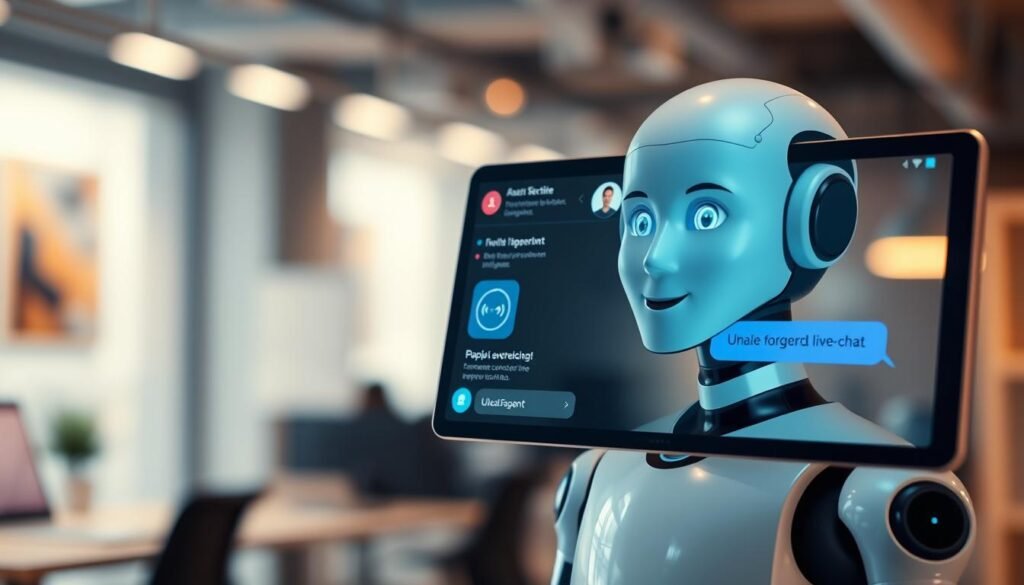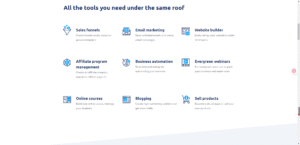I remember the first time a midnight rush hit our support queue. Messages blinked faster than I could read. I felt the pull between speed and care, and I knew something had to change. That moment led me to livechat ai—not as a buzzword, but as a way to serve people better in real time.
Today, I see intelligent live chat as the front door to trust. With ai customer support that blends automation, intent detection, and agent assist, I can resolve the routine and stay present for the hard stuff. Brands like AkzoNobel cut response time from nearly six hours to 70 minutes, and teams using ai-powered live chat often resolve tickets 52% faster. Average handle times drop around 40%, while customer happiness rises about 25%.
What changed? Conversational ai now reads context, routes smartly, and suggests precise replies. It can summarize threads, sense tone, and tap the knowledge base before I even type. That lets me offer proactive help, keep promises, and personalize at scale—without losing the human touch.
This article maps the journey: why AI matters now, how NLP and machine learning power intelligent live chat, the core features that drive results, data readiness and KPIs, trust and compliance, integrations across your stack, industry ROI, and the tech trends shaping what comes next.
Key Takeaways
- LiveChat AI blends real-time chat with automation for faster, more consistent care.
- AkzoNobel’s response time fell from nearly six hours to 70 minutes with AI-driven support.
- Teams using ai-powered live chat often resolve tickets 52% faster with ~40% lower handle times.
- Conversational ai enables intent detection, sentiment analysis, and knowledge-based answers.
- Intelligent live chat routes issues to the right experts while freeing agents for complex cases.
- ai customer support scales personalization with summaries, suggestions, and proactive outreach.
Why AI Matters in Modern Customer Service
I see customers judge brands by speed, clarity, and care. That is why I rely on livechat ai and intelligent live chat to meet rising expectations without burning out teams. With ai customer support and chat automation in place, I can route issues faster and keep tone on-brand, day and night.

Faster responses and lower handle times backed by real results
I measure success in minutes saved and problems solved. Organizations using automated live chat often resolve tickets about 52% faster, and average handle time can drop by roughly 40%. AkzoNobel cut response time to 70 minutes, which shows how speed scales when ai customer support pairs with good workflows.
Customers notice the lift. With intelligent live chat triaging routine tasks, I keep queues short and keep agents focused. Customer happiness can climb by about 25% when people get quick, consistent answers that match intent.
How AI reduces agent stress and improves consistency
When pressure spikes, ai customer support reduces cognitive load. Deloitte reports teams using AI are 35% less likely to feel overwhelmed by too much information during calls. I lean on instant knowledge base access, smart suggestions, and sentiment cues to steady the pace.
Consistency matters as much as speed. Automated live chat delivers uniform, rules-based answers, no matter the hour. That reduces errors tied to fatigue and keeps brand voice aligned across channels through livechat ai.
Balancing automation with human‑problem solving
I run a hybrid model. Chat automation handles FAQs, order tracking, returns, and status checks. When issues get complex, intelligent live chat detects sentiment or complexity and hands off to the right person with full context.
LiveChat enhances this flow with intent detection, AI suggestions, and crisp summaries, so agents jump in fast and finish strong. That balance lets me scale service without losing the human touch customers expect.
| Capability | What AI Handles | When Humans Step In | Impact on Metrics |
|---|---|---|---|
| Automated Live Chat | FAQs, order status, scheduling, returns | Policy exceptions, complex billing, multiparty cases | Up to ~40% lower AHT; faster first replies |
| Intent & Sentiment | Routing by topic and mood in real time | De‑escalation and sensitive conversations | Higher CSAT; fewer transfers |
| Agent Assist | Knowledge surfacing, response drafts, summaries | Final judgment, personalization, approvals | 52% faster resolutions; reduced agent stress |
| Quality & Consistency | Style and policy checks at scale | Edge cases and nuanced exceptions | More uniform answers; fewer reopens |
How Natural Language Processing Powers Intelligent Live Chat
I use natural language processing to help intelligent live chat systems “read” full sentences, not just match keywords. By tracking context across turns, the engine understands intent, sentiment, and urgency. This is how conversational ai stays clear and helpful even when a question is vague or mixed with follow‑ups.

NLP that understands intent beyond keywords
I rely on models that map meaning, so a virtual assistant chatbot knows when “I can’t log in” is a reset request, not a sales lead. BERT‑style embeddings capture relationships between words, while transfer learning adapts the model to new brands and domains. The result is ai-powered live chat that recognizes tone, purpose, and context.
These gains make chatbot technology faster and more precise. The system links prior messages to the current one, so it can keep track of who, what, and why without asking you to repeat details.
From product questions to returns: real use cases
- Answer product specs and compatibility checks in retail.
- Track orders and shipment ETAs with live status updates.
- Initiate or guide returns and exchanges with step‑by‑step flows.
- Help with website navigation when menus confuse shoppers.
- Troubleshoot common issues, like password resets or pairing devices.
- Suggest plan upgrades in telecom when usage patterns change.
By handling these tasks, intelligent live chat reduces queues while routing edge cases to agents with full context. I see conversational ai deliver quick wins and fewer back‑and‑forths.
Machine learning and GenAI for human‑like replies
Machine learning spots patterns across chats, improves intent labels, and builds memory across sessions. When a user returns, the virtual assistant chatbot recalls preferences and speeds up the next step. Generative models shape clear, natural replies in real time, then summarize threads for agents.
With embeddings, transfer learning, and multilingual tuning, ai-powered live chat scales across regions and products. It also fuels smart routing, real‑time suggestions, and concise recaps—features that elevate chatbot technology from simple scripts to guided conversations.
| Capability | What NLP Adds | Business Impact | Real‑World Example |
|---|---|---|---|
| Intent Detection | Understands purpose beyond keywords using context embeddings | Higher first‑contact resolution | Detects “wrong size” as a return request, not product feedback |
| Context Tracking | Maintains conversation state across turns | Shorter chats, fewer repeats | Remembers prior order number when switching from status to refund |
| GenAI Response | Generates human‑like, brand‑aligned messages | Better CSAT and clarity | Explains exchange policy in plain, friendly language |
| Smart Routing | Scores complexity and urgency from language cues | Faster escalations when needed | Sends suspected fraud to a specialist queue instantly |
| Summarization | Condenses long chats into agent‑ready notes | Quicker handoffs | Creates a clean timeline for a return plus replacement request |
livechat ai
I use livechat ai to meet customers where they are on web and mobile, and I keep replies fast and clear. With ai-powered live chat, I deliver instant answers, route intent to the right team, and offer agent assist that cuts cognitive load. Smart prompts suggest replies, while automatic summaries keep our CRM tidy and ready for the next handoff.
Through chatbot integration, I connect conversations with Shopify, WordPress, HubSpot, and Salesforce. That lets me track visitors, tag chats, share files, and trigger workflows for orders, returns, and lead capture. The same automated live chat handles FAQs, appointment booking, and follow-ups on Messenger and WhatsApp for true omnichannel coverage.
My setup pairs ai customer support with human judgment. I rely on intent detection for accurate routing and use canned responses to keep tone consistent. Predictive analytics helps me reach out before issues escalate, improving resolution speed and holding quality steady across peaks.
I can tailor widgets to brand style and surface past interactions for personal context. That context fuels ai-powered live chat to recommend next steps, deflect simple tickets, and free agents for complex cases. As needs grow, I can scale from Starter to Enterprise with features like Text Intelligence, staffing forecasts, HIPAA compliance, SSO, and dedicated onboarding support from LiveChat.

Core Capabilities: AI-Powered Live Chat, Routing, and Automation
I use ai-powered live chat to meet customers at the moment of need. With modern chatbot technology and tight chatbot integration, I keep conversations fluid across channels and systems. The result is faster help, fewer transfers, and clear next steps.
These capabilities work together to speed resolution, improve accuracy, and keep tone consistent from the first hello to the final wrap-up.

Intent detection and intelligent routing to the right team
I classify messages as purchase intent, refunds, technical issues, or account questions in seconds. The system then routes chats to billing, support, or sales without manual triage.
This reduces back-and-forth and boosts first-contact resolution. When needed, automated live chat adds clarifying questions to confirm intent before handoff.
Chat automation that handles FAQs, orders, and scheduling
With chat automation, common tasks no longer wait in the queue. Customers get instant answers on return policies and product availability, plus real-time order tracking.
I also offer secure appointment scheduling and data capture. If signals point to high complexity or risk, ai-powered live chat triggers escalation to a human agent right away.
AI suggestions, summaries, and agent assist
During live sessions, I provide context-aware reply suggestions that match brand voice. Sentiment cues guide tone shifts in real time, so tough moments stay calm and clear.
After each conversation, automated live chat produces concise summaries and follow-up tasks. With chatbot technology linked to the knowledge base, both customers and agents see instant article suggestions that speed accurate answers.
Together, these tools, backed by smart chatbot integration, drive faster response times, quicker ticket resolution, and steady gains in AHT and CSAT.
Personalization at Scale With Conversational AI
I use conversational ai to make every chat feel one-to-one. By blending data from browsing patterns, purchase history, and past messages, I can shape answers in real time. This turns intelligent live chat into a guide that knows context, remembers choices, and adapts tone without being intrusive.
Using past interactions and preferences to tailor replies
When someone buys a laptop from Apple or Dell, I suggest the right case, a USB‑C hub, or AppleCare based on the exact model. In ai-powered live chat, I skip asking for screenshots if they already shared them last week. I tailor fix steps to the user’s device, OS, and account level so the path to success is shorter.
In ai customer support, the virtual assistant chatbot recalls shipping choices, preferred stores like Best Buy, and color options. That memory keeps replies brief, relevant, and clear. It also reduces repeats that waste time for the customer.
Predictive analytics for proactive outreach
I track signals such as repeat visits to a help page, failed checkout attempts, or searches for error codes. With predictive analytics, intelligent live chat can trigger a gentle prompt or a follow-up email before a ticket forms. That reduces churn risk and prevents small issues from growing.
If a warranty is about to expire, I nudge with the right plan at the right moment. If delivery delays appear in tracking data from UPS or FedEx, I alert the buyer with options, not excuses. These cues make support feel timely and human.
Self‑service that feels personal, not generic
I design portals where ai-powered live chat and smart search surface answers that fit the user’s products and region. Personalized FAQs and interactive guides update as behavior changes, and escalation to a human is always one click away in tools like Zendesk or Salesforce.
Real-time translation lets me serve customers in Spanish, French, or Japanese without waiting for a specialist. The virtual assistant chatbot keeps the meaning intact, so people get help fast and in their own language. That is how ai customer support scales without losing the personal touch.
Building Trust: Transparency, Compliance, and Reliability
I set clear guardrails for ai customer support so people know what happens to their data and who can see it. I disclose when conversational ai or intelligent live chat is in use, and I explain what is stored, for how long, and why. This clarity builds confidence before a single message is sent.
I use encryption in transit and at rest, mapped to GDPR and CCPA requirements. I run regular security audits, document data flows, and restrict access with role-based controls. For sensitive signals, I favor federated learning and differential privacy to reduce raw data exposure while improving automated live chat quality.
Data security, GDPR/CCPA, and encryption best practices
- I apply TLS for chats and AES-256 for stored logs, with key rotation and monitoring.
- I honor data subject rights: access, delete, and opt out under GDPR and CCPA.
- I minimize retention and mask payment or health fields inside chatbot technology pipelines.
- I track model changes and run red-team tests to spot leakage risks early.
Clear escalation paths to human agents
When automated live chat reaches its limit, I route the conversation to a person fast. I show the handoff status, share the chat history, and keep the user’s place in line. This keeps context intact and avoids repeat questions.
- Users can request a human at any time with a single tap or keyword.
- Priority rules send billing, legal, and safety issues straight to trained staff.
- Service-level targets ensure intelligent live chat does not block urgent cases.
Avoiding pitfalls from public chatbot failures
Real missteps guide my approach. Apple faced backlash when human contractors reviewed Siri recordings without clear consent. I ask for permission up front and provide opt-out controls. TSB’s chatbot struggled to understand queries and escalated poorly, so I keep intent detection tuned and escalation simple.
Air Canada’s chatbot shared wrong refund advice and the airline lost a lawsuit. I align conversational ai answers with current policy, add citations inside internal tools for agents, and lock high-risk replies behind verification checks.
- Bias and error monitoring runs weekly, with retraining on diverse data.
- Correction workflows let agents flag and fix flawed responses quickly.
- Content filters and rate limits prevent off-policy or unsafe outputs.
With these practices, ai customer support powered by chatbot technology stays accurate, respectful of privacy, and ready to hand off, keeping trust at the center of every exchange.
Integrations and Chatbot Integration Across Your Stack
I bring every touchpoint into one flow so teams move faster and customers get answers without friction. With chatbot integration woven into my stack, ai-powered live chat and intelligent live chat features tap the same data, keeping ai customer support consistent across tools. Thoughtful chat automation ties it all together as volume grows.
CRM, ecommerce, and help desk connections
I sync conversations with Salesforce, HubSpot, and Zendesk Sell to keep records current and trigger follow-ups. Orders and carts from Shopify, BigCommerce, and WooCommerce surface inside the thread, so I can resolve issues or recommend items in real time. For service handoffs, Freshdesk, Help Scout, and Zendesk Support capture context from ai-powered live chat without copy‑paste.
This approach lets intelligent live chat draw on profiles, purchase history, and case notes. The result is ai customer support that feels personal while chat automation handles routine steps like logging, tagging, and scheduling.
Omnichannel support via web, mobile, and social
I manage website widgets, iOS and Android in-app chat, and social channels like Facebook Messenger, Instagram, Twitter, and WhatsApp from one dashboard. Customers start on mobile and continue on web without losing context, and agents see a single timeline.
With unified routing, ai-powered live chat keeps tone and intent steady across channels. Smart chatbot integration ensures that alerts, SLAs, and notes flow, while chat automation handles after-hours replies and follow-ups.
APIs and Zapier for custom workflows
Open APIs and Zapier let me connect line-of-business systems and launch bespoke triggers. I can push chat summaries to a data warehouse, update inventory tools, or kick off approvals in project apps, all without breaking the stack.
This flexibility supports scale. Intelligent live chat adapts as new apps arrive, and ai customer support keeps improving while chat automation removes manual steps that slow teams down.
| Integration Area | Key Platforms | What It Enables | Benefit to Teams |
|---|---|---|---|
| CRM | Salesforce, HubSpot, Zendesk Sell | Unified profiles, deal updates, closed-loop logging | Fewer data gaps, faster follow-ups, accurate reporting |
| Ecommerce | Shopify, BigCommerce, WooCommerce | Live cart and order data inside chat | Quicker refunds, real-time recommendations, reduced abandonment |
| Help Desk | Freshdesk, Help Scout, Zendesk Support | Seamless chat-to-ticket handoffs with context | Lower handle time, clearer SLAs, better first-contact resolution |
| Omnichannel | Web, iOS/Android, Messenger, Instagram, Twitter, WhatsApp | Continuous conversations across devices and social | Consistent experiences, fewer repeats, higher CSAT |
| APIs & Automation | Public APIs, Zapier | Custom triggers, data sync, workflow orchestration | Faster launches, lower ops overhead, future-proof scale |
Operational Wins: Speed, Ticket Deflection, and Agent Efficiency
I see the biggest gains when automated live chat meets strong process design. With intelligent live chat and livechat ai, I trim idle time, surface answers faster, and keep teams focused on work that needs a human touch. This is where ai customer support and chat automation earn their keep.
Proof in minutes and tasks handled shows up across real operations. Response times drop from hours to under an hour, AHT falls by about 40%, and tickets resolve roughly 52% faster while satisfaction rises. These shifts compound as volume grows.
Cutting response times and resolving tickets faster
I route by intent so urgent issues skip queues. Intelligent live chat drafts clear replies, and agents confirm with one click. Summaries shorten handoffs, so follow-ups do not restart from scratch. The result is faster first replies and fewer back-and-forths.
For high-volume windows, chat automation scales on demand. It holds context across channels, which keeps customers from repeating details and keeps the clock in check.
Knowledge base suggestions for customers and agents
Automated live chat recommends precise articles the moment a user types a question. It can guide self-service for shipping checks, invoice edits, or returns without an agent. I also get instant snippets pulled from policies and past fixes, which lifts first-contact resolution.
When a case escalates, ai customer support attaches sources to the draft reply. That boosts accuracy and speeds approvals in regulated workflows.
Sentiment analysis to adapt tone in real time
I use sentiment cues to switch tone, slow down, or escalate. If frustration rises, livechat ai prompts a concise apology and a clear next step. When satisfaction is detected, it nudges for a gentle upsell or feedback request.
Banks model this well: emotion signals guide outreach and wording, and structured feedback loops inform updates. With chat automation and intelligent live chat working together, the system protects empathy at scale.
Implementation Playbook: Data Readiness, Training, and KPIs
I start by aligning people, data, and goals so rollout feels smooth, not rushed. My plan centers on clean inputs, clear training, and steady metrics that prove value. This lets ai customer support scale without losing the human touch of intelligent live chat.
I consolidate records from CRM, help desk, and chat history into one source of truth. With LiveChat and livechat ai, I map IDs, normalize fields, and sync past interactions. That unlocks crisp intent detection, strong personalization, and reliable chatbot integration across channels.
Unifying customer data for accurate, personalized AI
I merge profiles, orders, and prior messages so context follows the customer. Clean schemas and deduped contacts keep chat automation precise. I tag topics, sentiment, and outcomes to fuel intelligent live chat that adapts in real time.
Agent onboarding with canned responses and trainer tools
I begin with repetitive tasks such as FAQs and order tracking. Canned responses drive consistency, while Agent Trainer–style tools review behavior and create quick quizzes. With message sneak‑peek, agents anticipate replies and keep ai customer support fast and on brand.
Measuring CSAT, FCR, and AI handoff rates
I track CSAT, first contact resolution, response and resolution times, and AI containment versus handoff. Escalations and post‑chat ratings show where chatbot integration needs tuning. LiveChat analytics, plus Google Analytics support, reveal trends so I refine flows and keep chat automation efficient.
- Data readiness: unified IDs, normalized fields, and labeled intents
- Training: canned replies, agent coaching, and scenario drills
- KPIs: CSAT, FCR, time to first response, containment, and escalations
I update knowledge bases, review transcripts, and adjust prompts each week. With livechat ai and intelligent live chat working in sync, the system learns from real use and improves with every conversation.
Advanced Chatbot Technology Trends to Watch
I track how rapid gains in chatbot technology shape everyday support. My focus is on tools that lift accuracy, cut effort, and keep tone human. The result is conversational ai that feels helpful, fast, and secure across brands people use daily.
BERT, transfer learning, and multilingual support
I see BERT improve context understanding, so intent and entities land right the first time. With transfer learning, I can fine‑tune models on smaller datasets and still reach high quality. This makes intelligent live chat scalable and cost‑effective.
Multilingual training lets one model serve English, Spanish, and more without resets. That boosts accessibility for global teams and powers ai customer support that adapts to regional terms and slang. It also speeds smarter routing and better agent suggestions.
Multimodal and omnichannel experiences
Customers now share text, voice, images, and even short video. I use ai-powered live chat that reads screenshots for error codes, listens for account numbers, and returns clear steps. Voice recognition links with IVR and assistants from Apple, Google, and Amazon to keep context.
Omnichannel continuity means no repeating the story. A user can start on a website, switch to WhatsApp, and finish in the app, and the thread stays intact. This is where conversational ai meets design, delivering one fluid journey across touchpoints.
Ethical AI: disclosure, bias mitigation, and privacy
I disclose when automation is active and offer a human handoff without friction. For privacy, I favor federated learning and differential privacy to reduce data exposure. These guardrails let chatbot technology learn while respecting user rights.
Bias monitoring runs on live samples with clear correction paths. I align continuous learning with U.S. and global data laws to keep ai customer support trustworthy. Done well, these steps make intelligent live chat both helpful and fair.
Industry Applications and ROI for Automated Live Chat
I see automated live chat reshaping how brands serve customers in the United States. With modern chatbot technology and chatbot integration into core systems, teams unlock faster answers, leaner workflows, and measurable gains. When I deploy ai customer support alongside intelligent live chat, I reduce wait times and control costs without losing the human touch.
Ecommerce, banking, insurance, healthcare, and manufacturing
In ecommerce, I use intelligent live chat to guide product discovery, track orders, and streamline returns. Retail sites powered by chatbot technology give real-time size hints, back-in-stock alerts, and fast exchanges that lift conversion.
Banks apply ai customer support to route intent, run balance checks, and detect distress through tone cues. Insurers automate onboarding checks and claims intake, while healthcare teams schedule visits, send reminders, and verify benefits with automated live chat. On factory floors, chatbot integration shares delivery updates and parts status to keep lines moving.
From fraud detection to returns and demand forecasting
I pair signals from transactions and device IDs to flag risky behavior in real time. For retail, I speed returns by capturing reasons up front, which feeds product quality feedback and smarter policies. With sales, weather, and promo data, I use models in ai customer support to forecast demand and prevent overstock or stockouts.
These workflows thrive when chatbot technology connects to inventory, ERP, and order systems. The result is automated live chat that answers “Where is my order?” and “Can I swap sizes?” with accurate, current data.
Resource optimization and dynamic scaling
I optimize spend with dynamic pricing rules and personalized offers, delivered through intelligent live chat. Text-to-Speech helps me handle repetitive calls with a warm tone, while agents focus on complex cases. Workforce schedules align with peak predictions, so queues stay short.
During volume spikes, smart deflection and routing balance bots and people. With tight chatbot integration, I scale support without hiring sprints, boost CSAT, and keep response times low—hallmarks of efficient ai customer support.
| Industry | High-Impact Use Case | Key Integration | Primary ROI Driver |
|---|---|---|---|
| Ecommerce | Guided shopping, order updates, returns automation | CMS, inventory, fulfillment | Higher conversion, lower WISMO contacts |
| Banking | Balance checks, card controls, sentiment-aware triage | Core banking, KYC, IVR | Faster resolutions, fewer branch calls |
| Insurance | Policy onboarding, claims intake, fraud screening | Policy admin, claims, identity verification | Reduced loss exposure, lower handling cost |
| Healthcare | Scheduling, reminders, benefits verification | EHR, patient portal, billing | Fewer no-shows, improved access |
| Manufacturing | Parts availability, delivery status, dealer support | ERP, MES, logistics | Shorter downtime, improved fill rates |
Conclusion
I close with a clear view: LiveChat AI merges real-time engagement, intent detection, automation, and agent assist into one engine for faster, more consistent, and more personal support. By pairing intelligent live chat with ai-powered live chat workflows, I can meet customers where they are and keep conversations moving across web, mobile, and social. The result is practical ai customer support that feels natural and useful.
The outcomes speak for themselves. I see shorter response and handle times, stronger CSAT, and less agent stress because repetitive tasks shift to conversational ai while complex cases escalate cleanly to humans. Reliable routing and summaries help teams act with context, while guardrails reduce errors and keep tone on brand.
The playbook is straightforward. I unify data to ground the model, start with repetitive use cases, train agents with AI tools, and track CSAT, FCR, and handoff rates. I keep improving knowledge bases and flows so intelligent live chat grows smarter with each interaction.
Trust is nonnegotiable. I disclose AI use, comply with GDPR and CCPA, encrypt data, and audit security to avoid the pitfalls seen at Apple, TSB, and Air Canada—accuracy and clear escalation come first. Looking ahead, BERT, transfer learning, multimodal inputs, and ethical design will raise the bar for ai-powered live chat. For U.S. businesses, livechat ai offers a scalable, future-ready foundation that delivers measurable gains in customer experience and operational efficiency.




